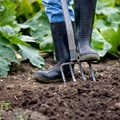Peat-free growing: the opportunities and challenges
The pressure from consumers and government to move towards peat-free growing media continues and we now have concrete deadlines set for the commercial horticulture industry to complete the transition.
This pressure has been met with some consternation by the industry due to concerns about the quality of some peat-free growing media. However, at Fargro, we have been working closely with our grower partners and growing media producers to develop peat-free mixes that ensure that the transition is as seamless as possible for the industry. We are now in a position to confidently say that there are peat-free growing media options that are more than suitable alternatives to peat for most crops, but there does remain some work to be done in specific areas.
We have now largely overcome the major issues faced when using peat-free media such as poor structure and the inability to retain water and nutrients. Significant developments in the ingredients available and the way mixes are put together have allowed us to help to develop media that produces equally robust and vibrant plants as in peat mixes. However, in some cases, there is a requirement to make alterations to growing habits – but these are very manageable, such as altering irrigation regularity or shifting to slow-release organic fertilisers.
We are now even beginning to see growers presented with a variety of opportunities to boost production, reduce inputs, and grow in a more ecologically friendly manner. We are working on trials with several producers of innovative products to hopefully bring products to market that will capitalise on these.
Opportunities:
In a nutshell, the main opportunities are:
• Improved control of root diseases: Peat-free mixes provide more oxygen around the root system and are less able to become oversaturated with water – minimising the opportunity for conditions to arise that are conducive to root diseases.
• Improved plant rooting: Improved oxygenation in the soil enables plant roots to establish well. This creates more vibrant plants with better capacity to withstand environmental and biological stresses. It also improves the ability of the plant to positively influence the environment in the growing media to facilitate beneficial interactions with root dwelling microbes.
• Improved scope for beneficial microbial activity: Many beneficial microbes, such as mycorrhiza and free-living nitrogen fixers, struggle to establish in peat but are well suited to peat-free mixes. The use of these beneficial microbes will improve the nutritional content of the soil and maximise the amount of these nutrients taken up by the plant – significantly reducing fertiliser requirements. We are currently working with a number of partners to explore the most effective means of achieving this.
There does, however, remain some work to be done in certain areas, but we are actively working on solutions for these.
Challenges:
• High pH: Unlike peat, the key ingredients of peat-free mixes have a relatively high pH, which has meant that growing ericaceous crops has been difficult. We are currently running trials with mixes containing specific nutrient profiles to manage the pH and they are showing promise with ericaceous crops.
• Ca availability: The ingredients are low in Calcium, which can be provided in peat media, with the addition of lime, but the already high pH makes this an unsuitable method as the mix would become too alkaline. This can be fixed with artificial fertiliser rich in Ca, but costs and environmental issues make this unattractive and so we are looking at the use of agricultural waste products that are rich in Calcium to supplement the growing media.
• Malleability: Peat-free mixes still have some issues when going through potting and propagation equipment.
• Potting: Peat flows well though potting machinery, but some peat-free mixes have had difficulties and so we are looking at additives which will improve their structure for this.
• Propagation: Peat-free plugs have often struggled to retain their structural integrity when being sown. We are looking into adhesives that will bind the mix more strongly and allow successful sowing.
There are now good options for peat-free growing and Fargro are here to help you support your transition away from peat. But - we’re not stopping here and are continually working on developing peat-free media for every situation that allow growers to operate more successfully than they did with peat, and in a more environmentally and financially sustainable manner.
This pressure has been met with some consternation by the industry due to concerns about the quality of some peat-free growing media. However, at Fargro, we have been working closely with our grower partners and growing media producers to develop peat-free mixes that ensure that the transition is as seamless as possible for the industry. We are now in a position to confidently say that there are peat-free growing media options that are more than suitable alternatives to peat for most crops, but there does remain some work to be done in specific areas.
We have now largely overcome the major issues faced when using peat-free media such as poor structure and the inability to retain water and nutrients. Significant developments in the ingredients available and the way mixes are put together have allowed us to help to develop media that produces equally robust and vibrant plants as in peat mixes. However, in some cases, there is a requirement to make alterations to growing habits – but these are very manageable, such as altering irrigation regularity or shifting to slow-release organic fertilisers.
We are now even beginning to see growers presented with a variety of opportunities to boost production, reduce inputs, and grow in a more ecologically friendly manner. We are working on trials with several producers of innovative products to hopefully bring products to market that will capitalise on these.
Opportunities:
In a nutshell, the main opportunities are:
• Improved control of root diseases: Peat-free mixes provide more oxygen around the root system and are less able to become oversaturated with water – minimising the opportunity for conditions to arise that are conducive to root diseases.
• Improved plant rooting: Improved oxygenation in the soil enables plant roots to establish well. This creates more vibrant plants with better capacity to withstand environmental and biological stresses. It also improves the ability of the plant to positively influence the environment in the growing media to facilitate beneficial interactions with root dwelling microbes.
• Improved scope for beneficial microbial activity: Many beneficial microbes, such as mycorrhiza and free-living nitrogen fixers, struggle to establish in peat but are well suited to peat-free mixes. The use of these beneficial microbes will improve the nutritional content of the soil and maximise the amount of these nutrients taken up by the plant – significantly reducing fertiliser requirements. We are currently working with a number of partners to explore the most effective means of achieving this.
There does, however, remain some work to be done in certain areas, but we are actively working on solutions for these.
Challenges:
• High pH: Unlike peat, the key ingredients of peat-free mixes have a relatively high pH, which has meant that growing ericaceous crops has been difficult. We are currently running trials with mixes containing specific nutrient profiles to manage the pH and they are showing promise with ericaceous crops.
• Ca availability: The ingredients are low in Calcium, which can be provided in peat media, with the addition of lime, but the already high pH makes this an unsuitable method as the mix would become too alkaline. This can be fixed with artificial fertiliser rich in Ca, but costs and environmental issues make this unattractive and so we are looking at the use of agricultural waste products that are rich in Calcium to supplement the growing media.
• Malleability: Peat-free mixes still have some issues when going through potting and propagation equipment.
• Potting: Peat flows well though potting machinery, but some peat-free mixes have had difficulties and so we are looking at additives which will improve their structure for this.
• Propagation: Peat-free plugs have often struggled to retain their structural integrity when being sown. We are looking into adhesives that will bind the mix more strongly and allow successful sowing.
There are now good options for peat-free growing and Fargro are here to help you support your transition away from peat. But - we’re not stopping here and are continually working on developing peat-free media for every situation that allow growers to operate more successfully than they did with peat, and in a more environmentally and financially sustainable manner.
Article Written by Jack Haslam, Technical Development Manager.
Contact number: 01903 256856
Contact email: technical@fargro.co.uk
Contact number: 01903 256856
Contact email: technical@fargro.co.uk

